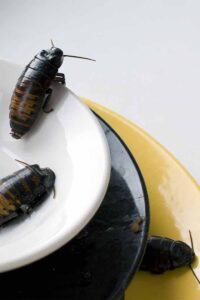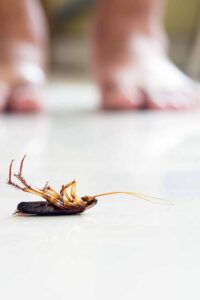GET RID OF COCKROACHES IN YOUR KITCHEN
They also like warm, dark, moist spaces. This adds up to your kitchen being a practically perfect insect habitat. But you really don’t want these beasts in your kitchen. In addition to simply being nasty, these insects carry a number of diseases, and their excrement can cause severe allergic reactions in some people.
Are you gagging yet? Pull yourself together and read on to learn how to prevent these vile beasts — also known as palmetto bugs — from taking up residence in your home.
PREVENTION IS THE BEST MEDICINE
The first step to keeping these icky bugs out of your kitchen is to keep them out of your garden, so they’re less likely to find their way into your home.
PLUG THE HOLES
Keep them out of your home by caulking cracks and crevices in your home’s foundation, in baseboards, and in walls.
Two of the most common types found in our yards and homes, the German and the American cockroaches, can crawl through incredibly tiny spaces — as thin as a dime — so be extra diligent about sealing up even the tiniest cracks or holes.

Cockroaches
Cockroaches, or “roaches”, are among the most important household pests. Indoor cockroaches are known as significant pests of public health, and outdoor species that find their way inside are considered serious nuisance pests as well as potential public health pests. Cockroaches range in size from less than 1/2 inch long to almost 2 inches long and are mostly nocturnal insects that feed on a wide range of organic matter
Most cockroaches harbor within moist, dark crevices when not foraging for food. They crawl quickly and may climb rough surfaces. A few species can fly short distances or glide as adults during warm nights, but most have no wings, reduced wings, or otherwise do not fly.
People are repulsed when they find cockroaches in their homes and other buildings. Indoor infestations of cockroaches are also important sources of allergens and have been identified as risk factors for development of asthma in children, especially within multi-unit housing environments. The levels of allergens present have been directly correlated to both cockroach density and the conditions that contribute to heavy infestations, such as housing disrepair and poor sanitary conditions.
IDENTIFICATION AND LIFE CYCLE
Cockroaches are medium-sized to large insects in the order Blattodea (superorder Dictyoptera). They are broad, flattened insects with long antennae and a prominent, shield-shaped section behind the head called the pronotum. Termites also belong to the Dictyoptera and are closely related to cockroaches.
Some people confuse cockroaches with beetles, but adult cockroaches have membranous wings and lack the thick, hardened forewings of beetles. Almost all cockroaches are nocturnal. They have a tendency to scatter when disturbed. Young or immature cockroaches, called nymphs, undergo gradual metamorphosis as they develop and grow into adults, which means they resemble adults and have similar feeding habits, but they do not have fully developed wings and are not reproductively active. Immediately after molting, cockroaches are white, but their outer covering darkens as it hardens, usually within hours. Nymphs are typically the most abundant stage of cockroach found in field populations.

Roaches Have Invaded My Home
People commonly look forward to fireflies, barbecue parties, picnics, fireworks, festivals and yukata in summer. But what people don’t look forward to is an uninvited house guest: the cockroach.
it also happens to be home to some species of roaches, and they just happen to be the ones that are disgustingly big and dark, and the ones that can fly. Typically, these nasty buggers come out during summer months (June-September), when the weather is warm, but some come out as early as April.
In my country, we have a saying that there’s no such thing as “macho” in the face of a flying cockroach—not even the toughest and biggest people want to deal with them
well, I’ve heard apocryphal tales of people taking up residence in nearby hotels when they see roaches in their apartment. That sounds like a tall tale, but in any case, it just goes to show that no one is happy to see even a single roach.
If you want to roach-proof your home, the first step is to make sure that your home is clean. Don’t leave litter scattered around, take out the trash regularly, don’t leave food waste in sinks, seal the cracks in your home, and spray your kitchen with one of those kitchen sprays that aren’t harmful to humans but make food waste less attractive to roaches and other pests.

Cockroach
There are more than 3,500 known roach species found throughout the world, many of which infest home kitchens, restaurants, hotels and grocery stores. More than $1.5 billion a year is spent controlling cockroaches in the United States alone. Their presence is so objectionable that roaches are considered among the worst of domestic pests.
Cockroaches consume human foodstuffs and contaminate them with saliva and excrement. They are responsible for transmitting diseases such as the bacteria which cause food poisoning and are a significant source of allergies indoors, second only to house dust
Identification
Adult house-infesting cockroaches are medium to large insects (1/2 – 2 inches long, depending on species) that vary in color from a light reddish brown to black. They have a broad, flattened shape, spiny legs and long, whip-like antennae. Roaches are active at night and will scatter quickly when disturbed by light. Immature stages (nymphs) resemble adults, but are smaller and have undeveloped wings.
Life Cycle
Adult female roaches produce egg capsules, which may contain up to 50 eggs. Some species carry them on their bodies until hatching takes place, while other drop the capsules in protected places that they frequent. After about 30 days young nymphs appear and begin their gradual development. As with all insects, roaches must shed their outer skin, or molt, to grow. Immediately after molting, they are white, but within hours their body becomes dark and hardens. Depending on the species, it may take a single cockroach as little as six weeks to become an adult or as long as a few years. There are several generations per year.
How to Control
Cockroach populations flourish where food and moisture are readily available. As a result, sanitation is an important step in prevention and management. Reduce the carrying capacity of your home by placing food and waste in sealed containers.
Reduce pest hiding places, like cracks and crevices, with caulk and paint.
Place glue traps along baseboards, near water pipes, behind refrigerators, in bathrooms and most locations where pests are found.
Wrap fine screen over vents and windows through which many crawling pests travel.
In a recent study, Orange Guard reduced roach populations better than Dursban, the toxic ingredient.
Dust Boric Acid lightly into cracks, crevices, wall voids and other insect hiding places. This fine powder clings to the legs, antennae and bodies of insects and acts as a stomach poison when consumed during grooming.
Food-grade diatomaceous earth contains no toxic poisons and works on contact. Lightly coat a thin layer over insect hiding places. Repeat treatment as necessary.
Shake moisture resistant Perimeter Ant Bait Plus around areas where insects are found. Results should be noticeable in a few days.
Least-toxic botanical insecticides should be used as a last resort. Derived from plants which have insecticidal properties, these natural pesticides have fewer harmful side effects than synthetic chemicals and break down more quickly in the environment.
Guide To Keeping Cockroaches Out Of Your Home
to treat for cockroaches quite often. These are dirty and pernicious pests that can poison food, taint food prep surfaces, and spread diseases and allergens throughout a structure. In fact, they are reported to spread six kinds of parasitic worms, over seven human pathogens, and at least 33 kinds of bacteria.
The roaches we see most are the American cockroach, the Oriental cockroach, and the brownbanded cockroach. But, while these cockroaches have different names, the pest control methods used to resist them are the same. Here’s what you need to know.
Before cockroaches come into your home, they come into your yard. Whether you already have a home infestation or you are looking to prevent one, these tips will help:
Seal exterior trash cans to keep smells in and cockroaches away.
Don’t leave any food around your home.
If you have compost, put it well away from your exterior walls.
Keep things as dry as possible. Cockroaches are moisture pests. Make sure your gutters are working and that you don’t have any areas of excessive shade that keep the sun from drying the ground after it rains.
Weeds and overgrowth will make cockroaches feel safe in your yard.
Lawn clutter is a playground for cockroaches and objects that clutter your yard will often hold rainwater cockroaches will drink from
Before cockroaches get into your home, they’ll find a hole in your walls. While there are many things you can do to seal up your exterior walls and foundation, you should know that this is not likely to fully exclude cockroaches. A complete barrier requires the use of pesticides, which can come with their own set of problems if not applied by a certified professional.
If you already have cockroaches inside your home, there is very little chance you’ll be able to get rid of them without assistance from someone with an education in pest control. Cockroaches have been living with humans since the dawn of time. They are skilled at avoiding all of our attempts to exterminate them. And, DIY control methods can be dangerous when the wrong products are used or applied in the wrong areas.